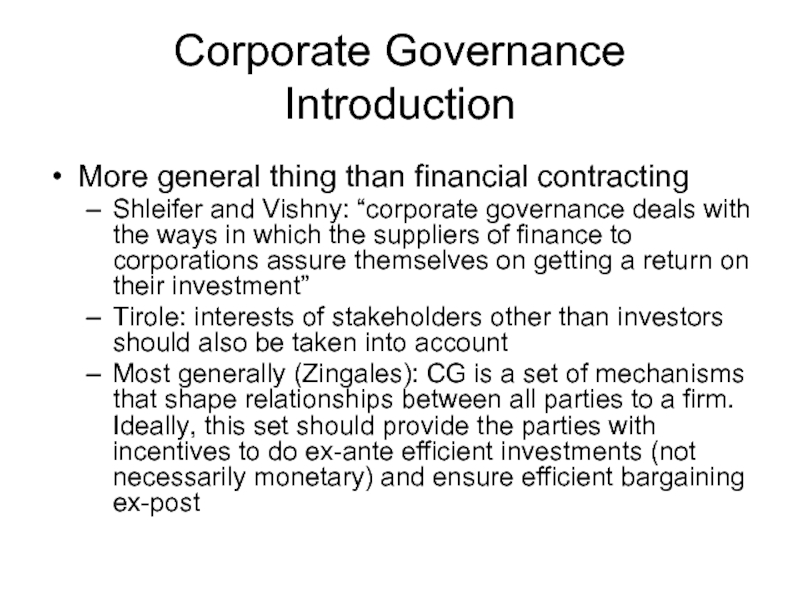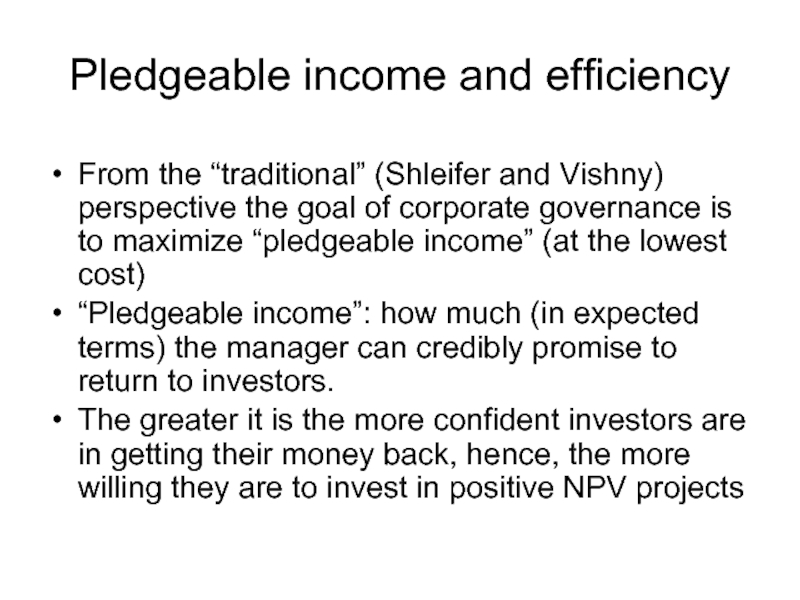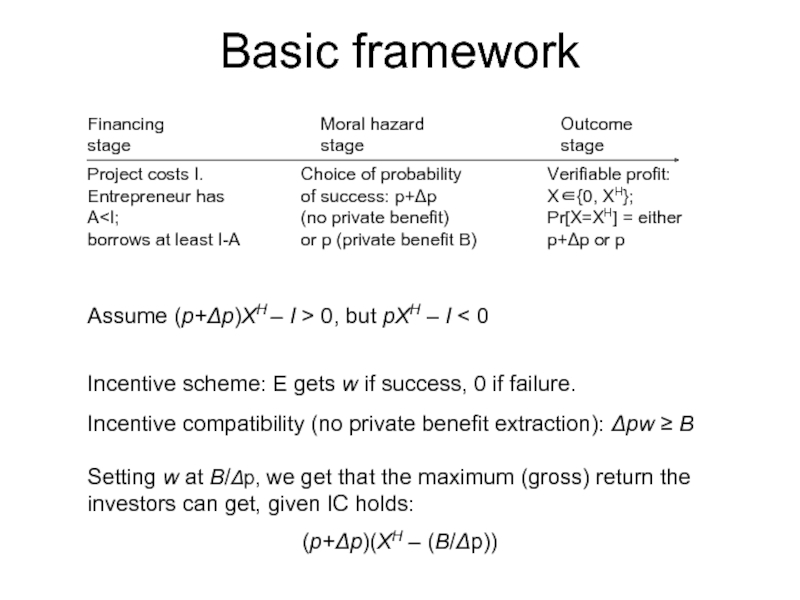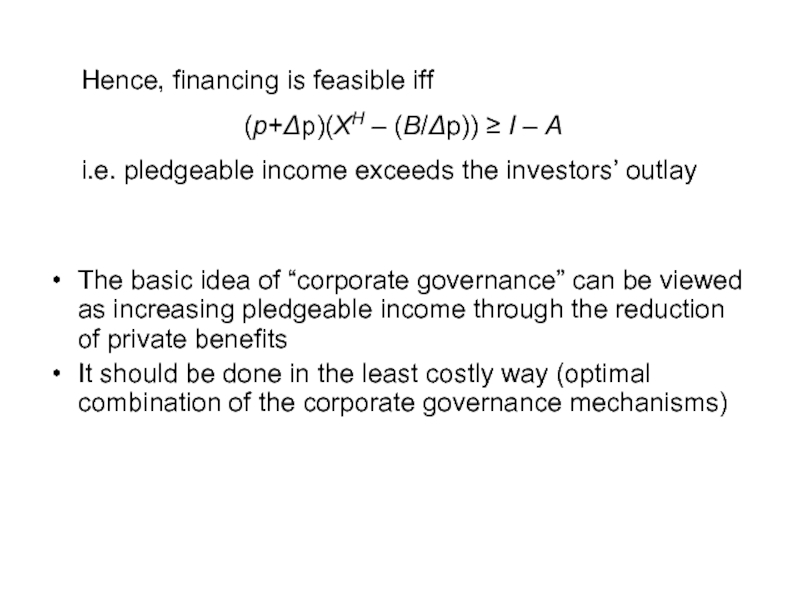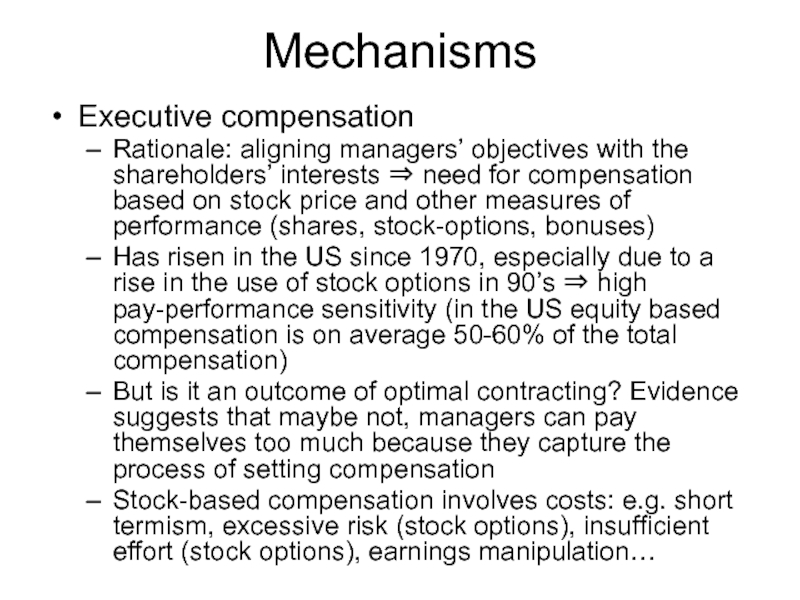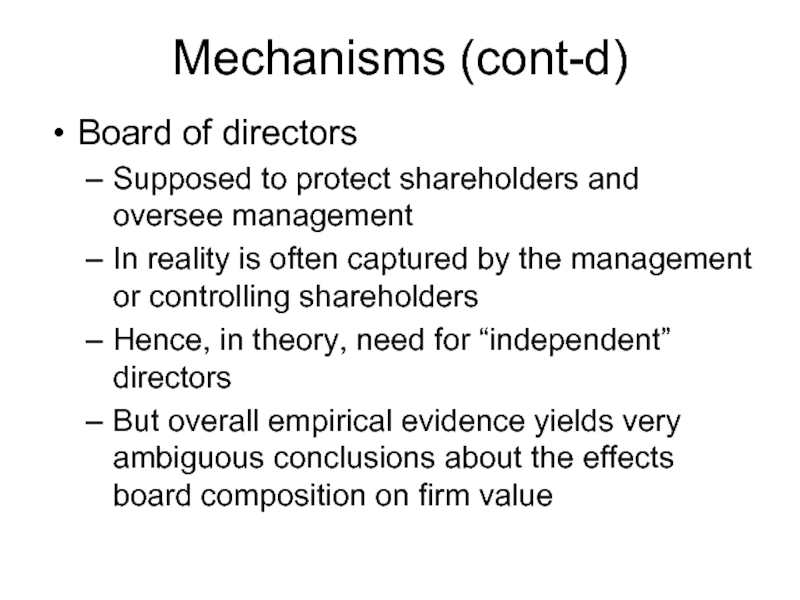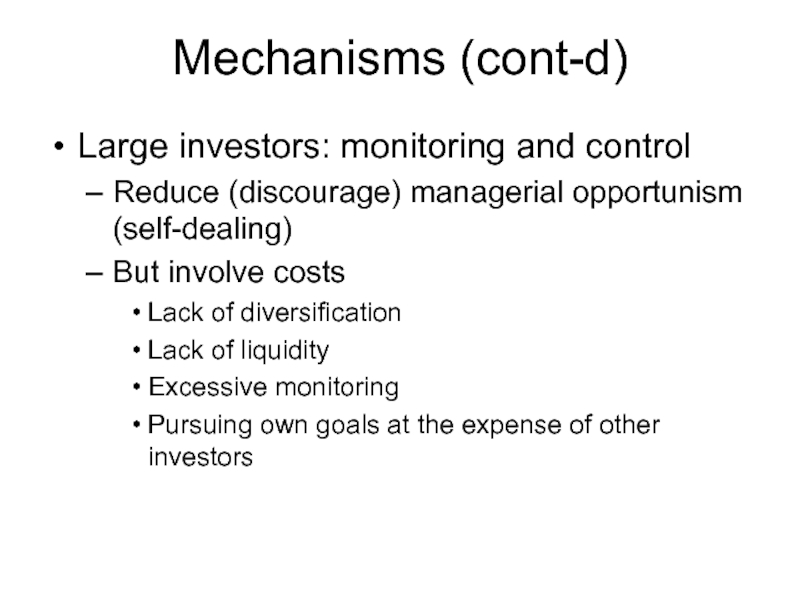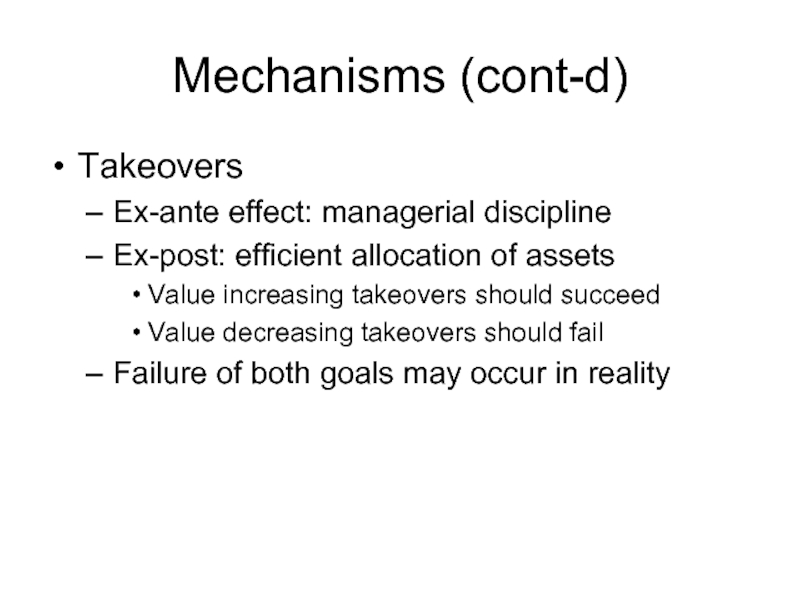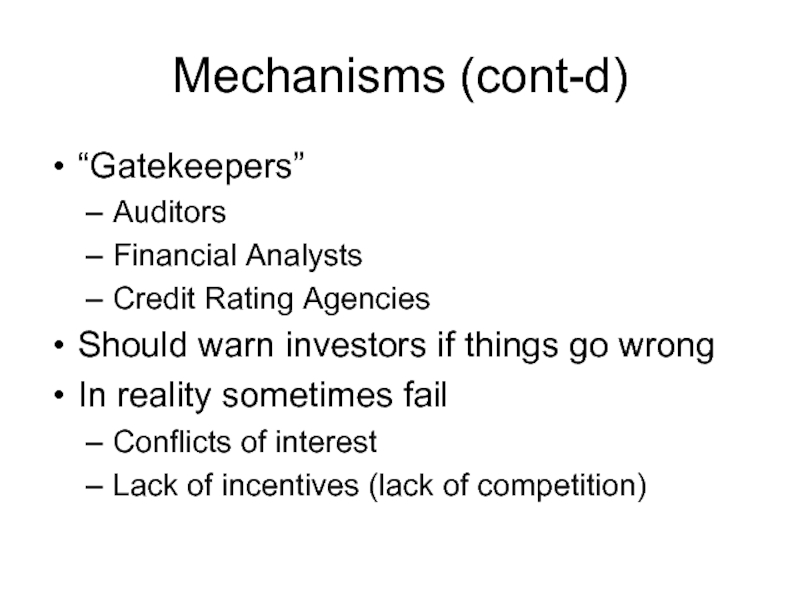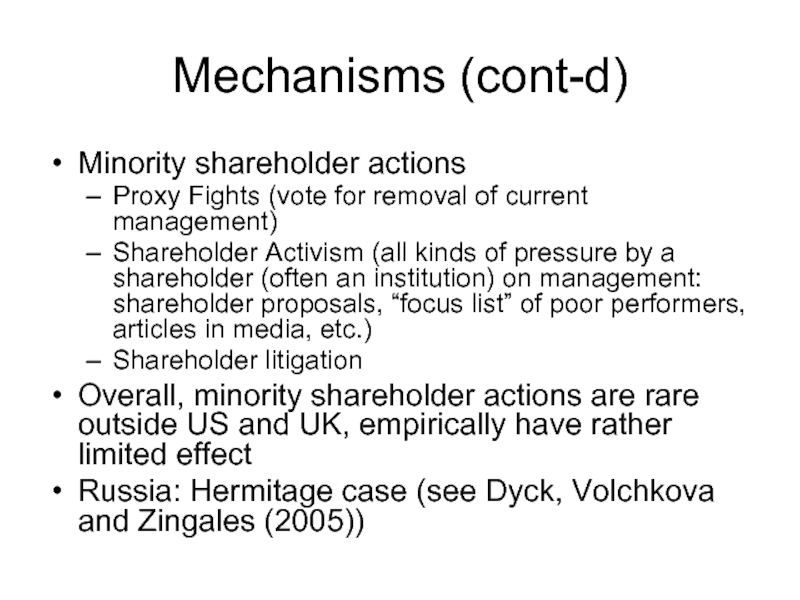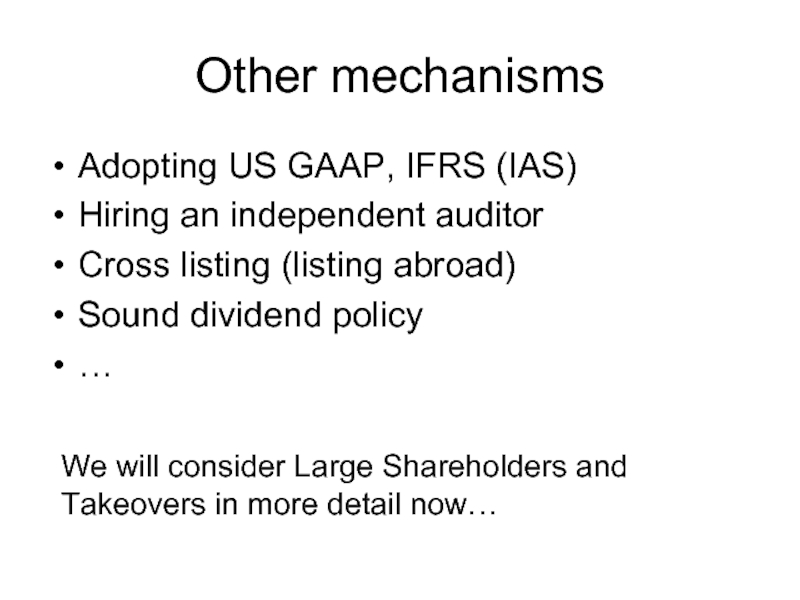- Главная
- Разное
- Дизайн
- Бизнес и предпринимательство
- Аналитика
- Образование
- Развлечения
- Красота и здоровье
- Финансы
- Государство
- Путешествия
- Спорт
- Недвижимость
- Армия
- Графика
- Культурология
- Еда и кулинария
- Лингвистика
- Английский язык
- Астрономия
- Алгебра
- Биология
- География
- Детские презентации
- Информатика
- История
- Литература
- Маркетинг
- Математика
- Медицина
- Менеджмент
- Музыка
- МХК
- Немецкий язык
- ОБЖ
- Обществознание
- Окружающий мир
- Педагогика
- Русский язык
- Технология
- Физика
- Философия
- Химия
- Шаблоны, картинки для презентаций
- Экология
- Экономика
- Юриспруденция
Corporate GovernanceIntroduction презентация
Содержание
- 1. Corporate GovernanceIntroduction
- 2. Pledgeable income and efficiency From the “traditional”
- 3. Basic framework Assume (p+Δp)XH – I >
- 4. The basic idea of “corporate governance” can
- 5. Mechanisms Executive compensation Rationale: aligning managers’ objectives
- 6. Mechanisms (cont-d) Board of directors Supposed to
- 7. Mechanisms (cont-d) Large investors: monitoring and control
- 8. Mechanisms (cont-d) Takeovers Ex-ante effect: managerial discipline
- 9. Mechanisms (cont-d) “Gatekeepers” Auditors Financial Analysts Credit
- 10. Mechanisms (cont-d) Minority shareholder actions Proxy Fights
- 11. Other mechanisms Adopting US GAAP, IFRS (IAS)
Слайд 1Corporate Governance
Introduction
More general thing than financial contracting
Shleifer and Vishny: “corporate governance
Tirole: interests of stakeholders other than investors should also be taken into account
Most generally (Zingales): CG is a set of mechanisms that shape relationships between all parties to a firm. Ideally, this set should provide the parties with incentives to do ex-ante efficient investments (not necessarily monetary) and ensure efficient bargaining ex-post
Слайд 2Pledgeable income and efficiency
From the “traditional” (Shleifer and Vishny) perspective the
“Pledgeable income”: how much (in expected terms) the manager can credibly promise to return to investors.
The greater it is the more confident investors are in getting their money back, hence, the more willing they are to invest in positive NPV projects
Слайд 3Basic framework
Assume (p+Δp)XH – I > 0, but pXH – I
Incentive scheme: E gets w if success, 0 if failure.
Incentive compatibility (no private benefit extraction): Δpw ≥ B
Setting w at B/Δp, we get that the maximum (gross) return the investors can get, given IC holds:
(p+Δp)(XH – (B/Δp))
Financing stage
Project costs I.
Entrepreneur has A Moral hazard stage Choice of probability of success: p+Δp
(no private benefit)
or p (private benefit B) Outcome stage Verifiable profit:
X∈{0, XH};
Pr[X=XH] = either p+Δp or p
Слайд 4The basic idea of “corporate governance” can be viewed as increasing
It should be done in the least costly way (optimal combination of the corporate governance mechanisms)
Hence, financing is feasible iff
(p+Δp)(XH – (B/Δp)) ≥ I – A
i.e. pledgeable income exceeds the investors’ outlay
Слайд 5Mechanisms
Executive compensation
Rationale: aligning managers’ objectives with the shareholders’ interests ⇒ need
Has risen in the US since 1970, especially due to a rise in the use of stock options in 90’s ⇒ high pay-performance sensitivity (in the US equity based compensation is on average 50-60% of the total compensation)
But is it an outcome of optimal contracting? Evidence suggests that maybe not, managers can pay themselves too much because they capture the process of setting compensation
Stock-based compensation involves costs: e.g. short termism, excessive risk (stock options), insufficient effort (stock options), earnings manipulation…
Слайд 6Mechanisms (cont-d)
Board of directors
Supposed to protect shareholders and oversee management
In reality
Hence, in theory, need for “independent” directors
But overall empirical evidence yields very ambiguous conclusions about the effects board composition on firm value
Слайд 7Mechanisms (cont-d)
Large investors: monitoring and control
Reduce (discourage) managerial opportunism (self-dealing)
But involve
Lack of diversification
Lack of liquidity
Excessive monitoring
Pursuing own goals at the expense of other investors
Слайд 8Mechanisms (cont-d)
Takeovers
Ex-ante effect: managerial discipline
Ex-post: efficient allocation of assets
Value increasing takeovers
Value decreasing takeovers should fail
Failure of both goals may occur in reality
Слайд 9Mechanisms (cont-d)
“Gatekeepers”
Auditors
Financial Analysts
Credit Rating Agencies
Should warn investors if things go wrong
In
Conflicts of interest
Lack of incentives (lack of competition)
Слайд 10Mechanisms (cont-d)
Minority shareholder actions
Proxy Fights (vote for removal of current management)
Shareholder
Shareholder litigation
Overall, minority shareholder actions are rare outside US and UK, empirically have rather limited effect
Russia: Hermitage case (see Dyck, Volchkova and Zingales (2005))
Слайд 11Other mechanisms
Adopting US GAAP, IFRS (IAS)
Hiring an independent auditor
Cross listing (listing
Sound dividend policy
…
We will consider Large Shareholders and Takeovers in more detail now…
